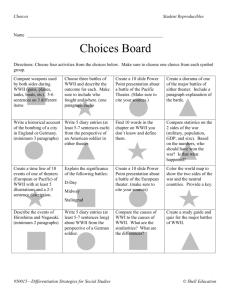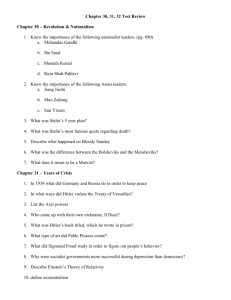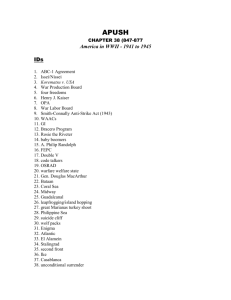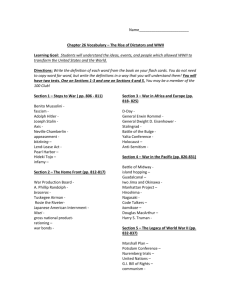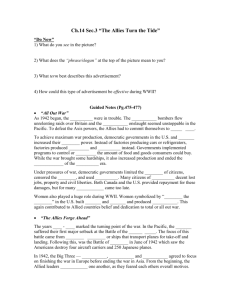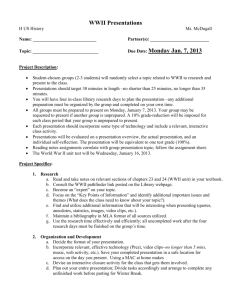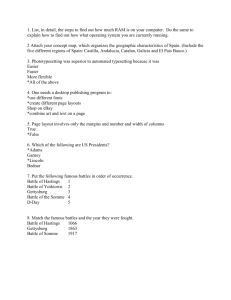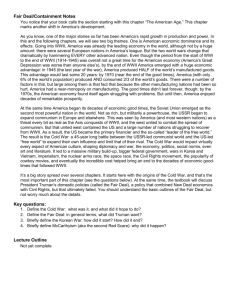File
advertisement
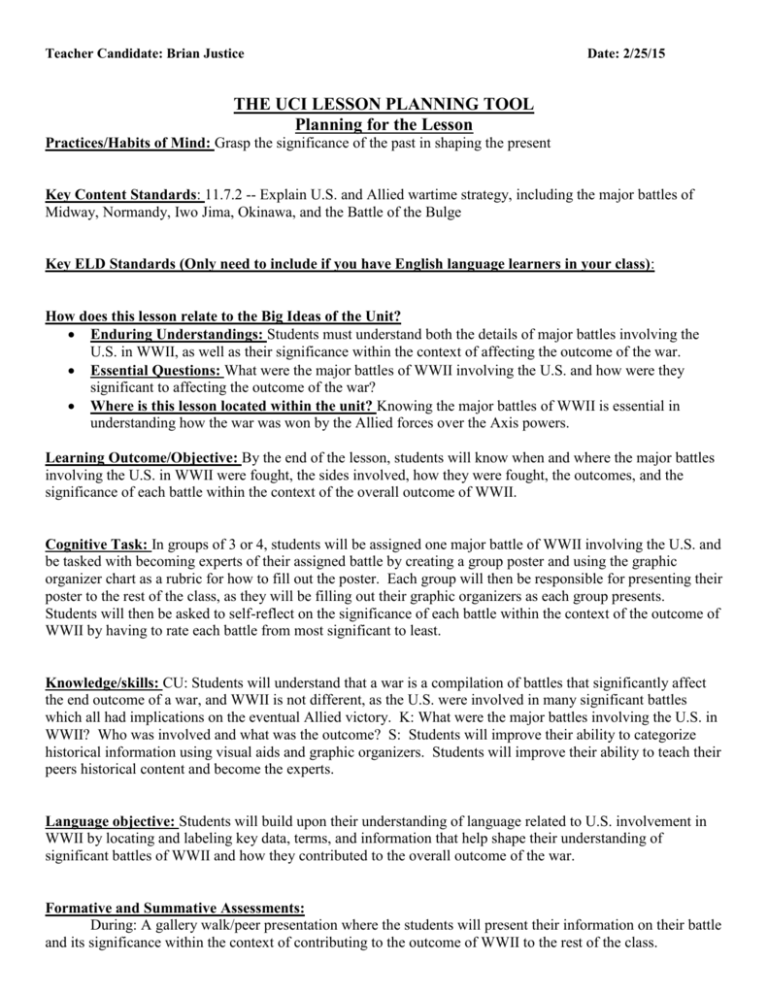
Teacher Candidate: Brian Justice Date: 2/25/15 THE UCI LESSON PLANNING TOOL Planning for the Lesson Practices/Habits of Mind: Grasp the significance of the past in shaping the present Key Content Standards: 11.7.2 -- Explain U.S. and Allied wartime strategy, including the major battles of Midway, Normandy, Iwo Jima, Okinawa, and the Battle of the Bulge Key ELD Standards (Only need to include if you have English language learners in your class): How does this lesson relate to the Big Ideas of the Unit? Enduring Understandings: Students must understand both the details of major battles involving the U.S. in WWII, as well as their significance within the context of affecting the outcome of the war. Essential Questions: What were the major battles of WWII involving the U.S. and how were they significant to affecting the outcome of the war? Where is this lesson located within the unit? Knowing the major battles of WWII is essential in understanding how the war was won by the Allied forces over the Axis powers. Learning Outcome/Objective: By the end of the lesson, students will know when and where the major battles involving the U.S. in WWII were fought, the sides involved, how they were fought, the outcomes, and the significance of each battle within the context of the overall outcome of WWII. Cognitive Task: In groups of 3 or 4, students will be assigned one major battle of WWII involving the U.S. and be tasked with becoming experts of their assigned battle by creating a group poster and using the graphic organizer chart as a rubric for how to fill out the poster. Each group will then be responsible for presenting their poster to the rest of the class, as they will be filling out their graphic organizers as each group presents. Students will then be asked to self-reflect on the significance of each battle within the context of the outcome of WWII by having to rate each battle from most significant to least. Knowledge/skills: CU: Students will understand that a war is a compilation of battles that significantly affect the end outcome of a war, and WWII is not different, as the U.S. were involved in many significant battles which all had implications on the eventual Allied victory. K: What were the major battles involving the U.S. in WWII? Who was involved and what was the outcome? S: Students will improve their ability to categorize historical information using visual aids and graphic organizers. Students will improve their ability to teach their peers historical content and become the experts. Language objective: Students will build upon their understanding of language related to U.S. involvement in WWII by locating and labeling key data, terms, and information that help shape their understanding of significant battles of WWII and how they contributed to the overall outcome of the war. Formative and Summative Assessments: During: A gallery walk/peer presentation where the students will present their information on their battle and its significance within the context of contributing to the outcome of WWII to the rest of the class. Closure: A ranking of all of the battles in which they will have to write at the bottom of their graphic organizer which battle they chose as the most significant towards the end outcome of WWII and their reasoning for it. Prerequisite Skills and Knowledge: CU: Students should already be cognizant of the world-wide impact of WWII and that it resulted in millions of deaths and a shift in world power resulting from the outcome of WWII. K: Students should be aware of U.S. involvement in WWII and that it had a significant impact on affecting the outcome of WWII. S: Students should know how to fill out a graphic organizer and follow its directions, as well as creating a poster using a graphic organizer as a rubric. Lesson Resources/Materials: 11 sheets of construction paper; a class set of markers; textbooks; technology devices such as phones and laptops. Students will be instructed to send one group member to go retrieve a piece of construction paper and markers for the poster-making portion of the lesson. Graphic organizers will be handed out by me with the help of my MT. At the end of the lesson, students will be instructed to turn in their markers back to the container. INSTRUCTIONAL SEQUENCE: ENGAGING STUDENTS IN THE LEARNING PROCESS Sequence/Groupings Teacher actions/questions Tied to Learning Outcomes Making thinking visible differentiation Student actions/possible student thinking Introduction (5 min. ) T: Students will be prepped on the lesson tasks for the day, be introduced to the learning objective question, and launched into the poster-making portion of the activity (0:00 – 5:00) By asking students if they have any questions on the lesson plan, task, or learning objective for the day, I can check for understanding that they listened to my instructions. n/a Body of the Lesson (80 min): SS: Work on poster-making activity on their assigned WWII battle, while also filling out their battle information outlined on their graphic organizer T: Walk around and monitor progress of SS while keeping them on task and answering any questions they may have. Attendance will also be taken at this time (5:00 – 25:00) T: Launch SS into gallery walk/jigsaw activity SS: Find a spot along the walls of the classroom to tape poster up and assign roles for presentation (25:00 – 30:00) Students will make learning visible in a number of ways. First, they will make their knowledge and understanding of their assigned battle visible through them filling out their graphic organizer and creating a poster of their assigned battle. Second, they will share their knowledge and understanding of their assigned battle to their peers through the group presentations. . A: SS will be conducting a gallery walk-style presentation of their posters where they will rotate every 2 minutes to a new poster where the assigned presenters will present their information related to their assigned battle SS: 1 or 2 students from each group will be assigned to be the presenters of their group’s poster and the other 1 or 2 students will be assigned to walk around and listen to the presenters present their posters. After one full rotation the roles will flip and we will have one additional full rotation T: Walk around and observing the poster presentations while announcing the next rotation every 2 minutes (30:00 – 85:00) Some groups may need help in finding information related to their assigned battle, which I will help them by pointing them to where they can find the information in the textbook. Some presenters may not fully present all of the components of their poster properly, which I could help with by asking questions to them that directly relates to their findings on their assigned battle. Closure (15_min.): T: Ask students to rank each battle in order of significance to outcome of WWII. Record results on the board. SS: Students will rank the battles on their graphic organizer (85:00 – 95:00) T: Instruct students to write reasoning for why they chose their most significant battle. Ask for volunteers to share out loud what they wrote to the class. SS: Write down reasoning for why they chose their most significant battle on bottom of graphic organizer and volunteer to share out loud their responses to the class (95:00 – 100:00) Their thinking will be made visible through their written arguments on which battle is the most significant to the outcome of WWII on their graphic organizers I can elicit student thinking by probing them on why certain battles would be deemed more significant to the outcome of WWII than others. For IEP students, I can modify the ranking systems for them where they could rank the battles according to which ones were their most favorite and ask for reasoning based off of their answers to that question. INCORPORATING ACADEMIC LANGUAGE 1. Restate the cognitive task related to the learning outcome: By the end of the lesson, students will know when and where the major battles involving the U.S. in WWII were fought, the sides involved, how they were fought, the outcomes, and the significance of each battle within the context of the overall outcome of WWII. 2. Language Functions: Identify key descriptive information regarding major WWII battles involving the U.S. and argue why certain battles are more significant than others using the language directly related to the content of WWII battles. 3. Language Demands: Vocabulary: New: Names of battles, such as Iwo Jima, Okinawa, and Normandy. Continued support: engagement, offensive. Previous: World War II, outcome Syntax: When presenting information, using linking words or phrases such as ‘in addition’ ‘as a result’ and ‘however’. When writing their arguments for most significant battle, using sentence starters such as “The most significant battle of WWII is…” When ranking, using comparative words such as ‘most’ or ‘least’ Discourse: During the poster-making and presentation tasks of the activity, students will be using descriptive language to communicate to their peers the content related to their assigned battles. During the ranking task, students will be using argumentative language, as the discourse will be one of taking their learned content and making it significant within the broader frame of the overall impact of WWII. 4. Language Objective: Students will build upon their understanding of language related to U.S. involvement in WWII by locating and labeling key data, terms, and information that help shape their understanding of significant battles of WWII and how they contributed to the overall outcome of the war. 5. Support: I will help students use new words to build ideas or create products, identify significance, and build arguments by having them fill out a graphic organizer that will also be utilized as a rubric, presenting their information to their peers, and obtaining all of the required content information through the use of a jigsaw activity.
